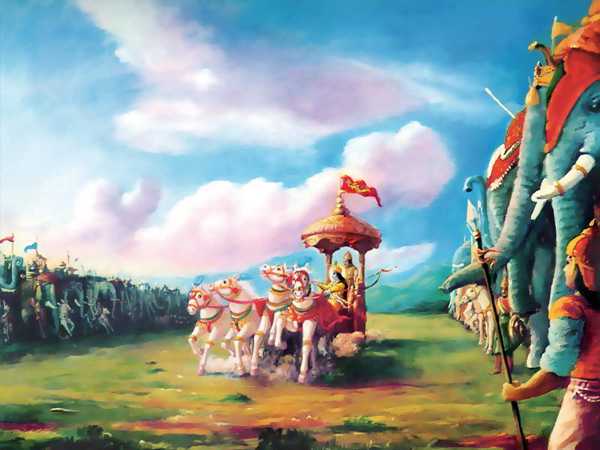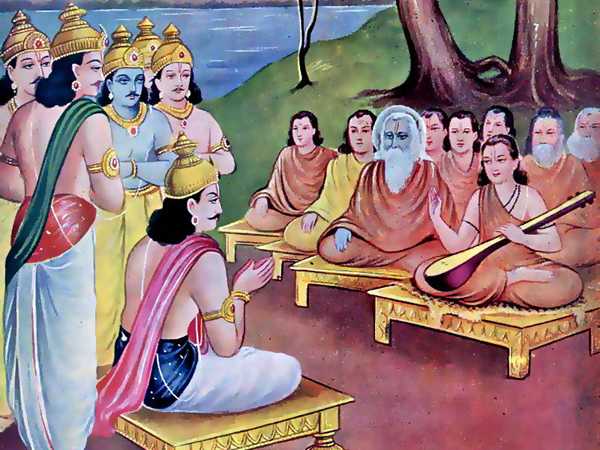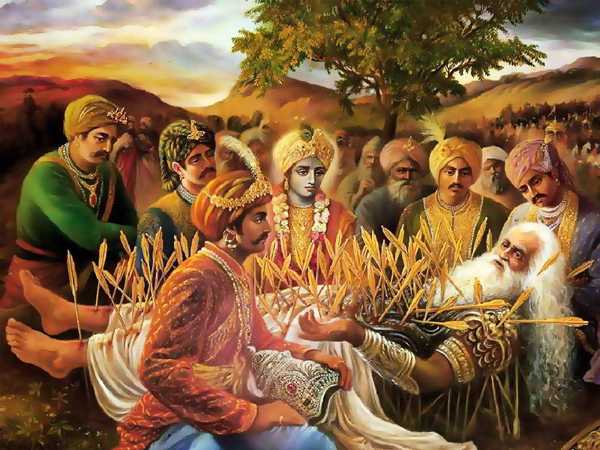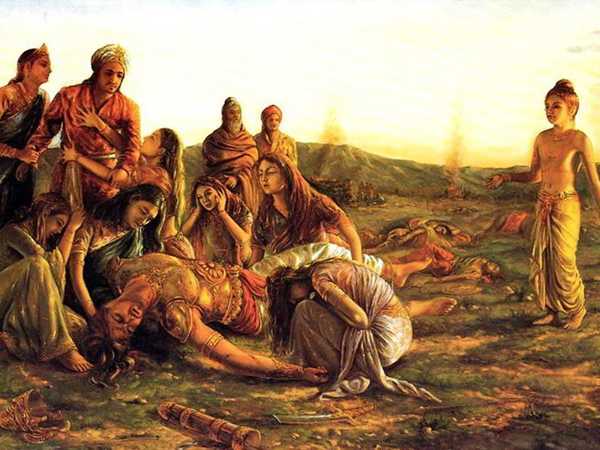Chapter 156

“Vaisampayana said, ‘After that night had passed away, king Duryodhana, OBharata, distributed (in proper order) his eleven Akshauhinis of troops.And arranging his men, elephants, cars, and steeds, into three classes,viz., superior, middling, and inferior, the king distributed them amongsthis divisions (by placing them in the van, centre, and rear of theranks). And furnished with timber and planks for repairing the damagestheir cars might sustain in the press of battle, with large quivers borneon cars, with tiger-skins and other stiff leather for enveloping thesides of cars, with barbed javelins to be hurled by the hand, withquivers borne on the backs of steeds and elephants, with long-handledspears of iron and missiles, with quivers borne on the backs offoot-soldiers with heavy clubs of woods, with flagstaffs and banners,with long heavy shafts shot from bows, with diverse kinds of nooses andlassoes, with armour of various kinds, with short-pointed clubs of wood,with oil, treacle, and sand, with earthen pots filled with poisonoussnakes, with pulverised lac and other inflammable matter, with shortspears furnished with tinkling bells, with diverse weapons of iron, andmachines, for hurling hot treacle, water, and stones, with whistlingclubs of hard wood, with wax and heavy mallets, with clubs of wood havingiron spikes, with plough-poles and poisoned darts, with long syringes forpouring warm treacle and planks of cane, with battle-axes and forkedlances with spiked gauntlets, with axes and pointed iron-spikes, withcars having their sides covered with skins of tigers, and leopards, withsharp-edged circular planks of wood, with horns, with javelins andvarious other weapons of attack, with axes of the kuthara species, andspades, with cloths steeped in oil, and with clarified butter, thedivisions of Duryodhana, glittering with robes embroidered with gold anddecked with various kinds of jewels and gems and consisting of warriorsendued with handsome persons, blazed forth like fire. And cased in coatsof mail and well-skilled in weapons, accomplished in horse-lore, bravepersons of good birth were employed as car-drivers. And all the cars werefurnished with various drugs, and with horses having rows of bells andpearls on their heads, and with banners and flagstaffs, and withornaments gracing their steeples and turrets and with shields, swords,and lances, and javelins and spiked maces. And unto each of those carswere yoked four steeds of the best breed. And upon each of them were kepta hundred bows. And each car had one driver in charge of the couple ofsteeds in front, and two drivers in charge of the couple of steedsattached to the wheels on the two sides. And both of the last-mentioneddrivers were skilled car-warriors, while the car-warrior himself was alsoskilled in driving steeds. And thousands of cars thus furnished anddecked with gold, and protected like fortified town and incapable ofbeing conquered by foes, were stationed on all sides. And the elephantsalso were furnished with rows of bells and pearls and decked with diverseornaments. And on the back of each of those animals, mounted sevenwarriors. And in consequence of such accoutrements those animals lookedlike hills graced with jewels. And amongst the seven, two were armed withhooks, two were excellent bowmen, two were first-rate swords-men, andone, O king, was armed with a lance and trident. And, O king, the army ofthe illustrious Kuru king, teemed with innumerable infuriate elephants,bearing on their backs loads of weapons and quivers filled with arrows.And there were also thousands of steeds ridden by brave soldiersaccoutred in mail, decked in ornaments, and furnished with flags. Andnumbering in hundreds and thousands, all those steeds were free from thehabit of scratching the ground with their forehoofs. And they were allwell-trained, and decked with ornaments of gold, and exceedingly obedientto their riders. And of foot-soldiers, there were hundreds of thousandsof diverse mien, accoutred in armours of diverse kinds and armed alsowith weapons of diverse species, and decked with golden ornaments. Andunto each car, were assigned ten elephants, and unto each elephant tenhorses, and unto each horse ten foot-soldiers, as protectors. Again, alarge body of troops was kept as a reserve for rallying the ranks thatwould be broken. And this reserve consisted of cars, unto each of whichwere attached fifty elephants; and unto each elephant were attached ahundred horses; and unto each horse were attached seven foot-soldiers.Five hundred cars, as many elephants (fifteen hundred horses, and twothousand five hundred foot-soldiers) constitute a Sena. Ten Senasconstitute a Pritana; and ten Pritanas, a Vahini. In common parlance,however, the words Sena, Vahini, Pritana, Dhwajini, Chamu, Akshauhini,and Varuthini are used in the same sense.
‘It was thus that the intelligent Kaurava arrayed his force. Between thetwo sides, the total number was eighteen Akshauhinis. Of this, thePandava force consisted of seven Akshauhinis, while the Kaurava forceconsisted of ten Akshauhinis and one more. Five times fifty menconstitute a Patti. Three Pattis make a Senamukha or Gulma. Three Gulmasmake a Gana. In Duryodhana’s army, there were thousands and hundred ofsuch Ganas consisting of warriors capable of smiting (the foe) andlonging for battle. And the mighty-armed king Duryodhana, selecting fromamong them brave and intelligent warriors, made them the leaders of histroops. And placing an Akshauhini of troops under each of those best ofmen, viz., Kripa, Drona, Salya, Jayadratha, the king of the Sindhus,Sudakshina the ruler of the Kamvojas, Kritavarman, Drona’s son(Aswatthaman), Karna, Bhurisravas, Sakuni, the son of Suvala, and themighty Vahlika, the king used to bring them daily before him and at allhours, and speak to them. And he repeatedly offered them worship beforehis very eyes. And thus appointed, all warriors, with all theirfollowers, became desirous of doing what was most agreeable to the king.'”




